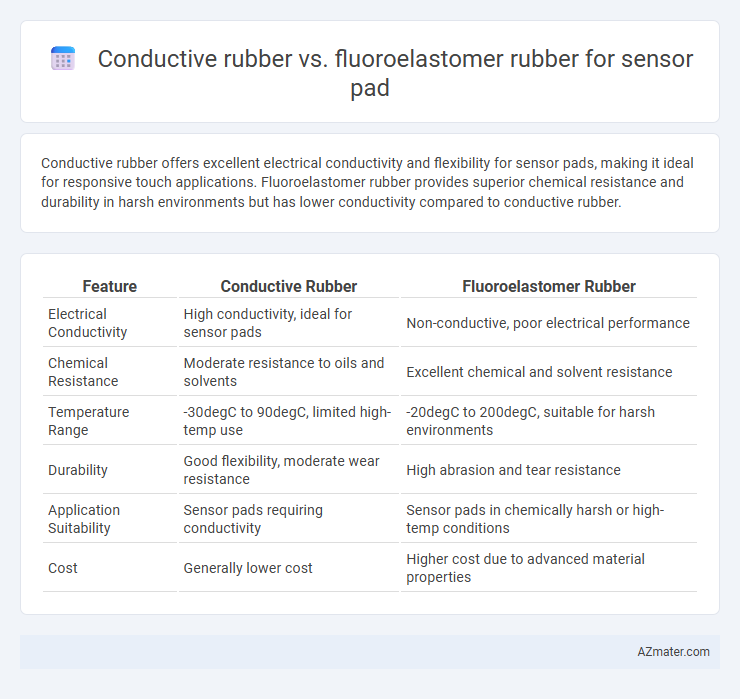Conductive rubber offers excellent electrical conductivity and flexibility for sensor pads, making it ideal for responsive touch applications. Fluoroelastomer rubber provides superior chemical resistance and durability in harsh environments but has lower conductivity compared to conductive rubber.
Table of Comparison
| Feature | Conductive Rubber | Fluoroelastomer Rubber |
|---|---|---|
| Electrical Conductivity | High conductivity, ideal for sensor pads | Non-conductive, poor electrical performance |
| Chemical Resistance | Moderate resistance to oils and solvents | Excellent chemical and solvent resistance |
| Temperature Range | -30degC to 90degC, limited high-temp use | -20degC to 200degC, suitable for harsh environments |
| Durability | Good flexibility, moderate wear resistance | High abrasion and tear resistance |
| Application Suitability | Sensor pads requiring conductivity | Sensor pads in chemically harsh or high-temp conditions |
| Cost | Generally lower cost | Higher cost due to advanced material properties |
Introduction to Sensor Pad Materials
Conductive rubber and fluoroelastomer rubber serve distinct roles in sensor pad materials due to their unique properties. Conductive rubber offers excellent electrical conductivity and flexibility, making it ideal for pressure-sensitive applications and reliable signal transmission. Fluoroelastomer rubber, characterized by superior chemical resistance and thermal stability, ensures durability and performance in harsh environments, expanding sensor pad functionality across industrial and automotive sectors.
Overview of Conductive Rubber
Conductive rubber used in sensor pads combines elastic polymer matrices with conductive fillers such as carbon black or silver particles, enabling reliable electrical signal transmission under mechanical deformation. This material offers excellent flexibility, durability, and responsiveness, making it ideal for applications requiring consistent sensor performance under repeated compression or bending. Conductive rubber provides superior contact resistance stability and enhanced sensitivity compared to traditional elastomers, ensuring accurate detection in pressure-sensitive devices.
Overview of Fluoroelastomer Rubber
Fluoroelastomer rubber offers exceptional chemical resistance, high-temperature stability up to 200degC, and superior durability, making it ideal for sensor pads exposed to harsh environments. Its low permeability to gases and excellent mechanical properties ensure long-lasting performance and reliability in demanding applications. Compared to conductive rubber, fluoroelastomer rubber provides enhanced resistance to oils, fuels, and solvents, ensuring sensor integrity under extreme conditions.
Electrical Conductivity Comparison
Conductive rubber exhibits significantly higher electrical conductivity than fluoroelastomer rubber, making it ideal for sensor pad applications requiring reliable signal transmission and low resistance. Fluoroelastomer rubber offers superior chemical resistance and durability but generally has lower conductivity, limiting its effectiveness where precise electrical performance is critical. For sensor pads demanding consistent and efficient electrical response, conductive rubber remains the preferred material due to its enhanced conductivity properties.
Chemical and Environmental Resistance
Conductive rubber sensor pads offer moderate chemical resistance but can degrade when exposed to harsh solvents, oils, and UV light, limiting their durability in aggressive environments. Fluoroelastomer rubber sensor pads provide superior chemical and environmental resistance, with excellent stability against fuels, acids, bases, ozone, and extreme temperatures, ensuring long-lasting performance in demanding industrial or automotive applications. The high fluorine content in fluoroelastomers contributes to their resistance to permeation and degradation, making them the preferred choice for sensor pads requiring reliable operation under aggressive chemical exposure.
Flexibility and Durability Analysis
Conductive rubber sensor pads offer excellent flexibility due to their elastomeric polymer matrix combined with conductive fillers, enabling reliable deformation under stress while maintaining electrical conductivity. Fluoroelastomer rubber provides superior durability with outstanding chemical and thermal resistance, ensuring sensor pad longevity in harsh environments and high-temperature applications. Comparative analysis highlights that conductive rubber excels in flexibility and consistent sensor response, whereas fluoroelastomer rubber delivers enhanced mechanical endurance and resistance to degradation over extended use.
Sensitivity and Performance in Sensor Pads
Conductive rubber offers high sensitivity and fast response times in sensor pads due to its excellent electrical conductivity and flexibility, making it ideal for detecting subtle pressure changes. Fluoroelastomer rubber provides superior chemical resistance and long-term stability, ensuring consistent sensor performance in harsh environments but with slightly reduced sensitivity compared to conductive rubber. Selecting between conductive rubber and fluoroelastomer depends on application priorities, balancing sensitivity for precise detection against durability under extreme conditions.
Applications in Sensing Technology
Conductive rubber excels in sensor pads requiring reliable electrical conductivity and flexibility, making it ideal for pressure and touch-sensitive devices in consumer electronics and industrial automation. Fluoroelastomer rubber offers superior chemical resistance and temperature stability, suitable for harsh environment sensors in automotive, aerospace, and chemical processing industries. Choosing between these materials depends on specific sensing application needs such as durability, electrical performance, and environmental exposure.
Cost Considerations and Availability
Conductive rubber offers a cost-effective solution for sensor pads due to its lower raw material expenses and widespread manufacturing processes. Fluoroelastomer rubber, while providing superior chemical resistance and durability, typically comes at a higher price point and may face limited availability from specialized suppliers. Choosing between these materials involves balancing budget constraints against performance requirements and procurement timelines.
Choosing the Right Rubber for Sensor Pads
Conductive rubber offers excellent electrical conductivity and flexibility, ideal for sensor pads requiring precise signal transmission and responsiveness. Fluoroelastomer rubber provides superior chemical resistance and thermal stability, making it suitable for sensor pads exposed to harsh environments or extreme temperatures. Selecting the right rubber depends on balancing electrical performance needs with environmental durability for optimized sensor functionality.

Infographic: Conductive rubber vs Fluoroelastomer rubber for Sensor pad
 azmater.com
azmater.com